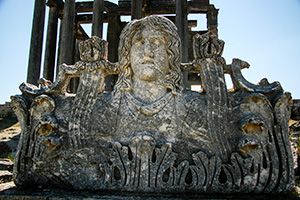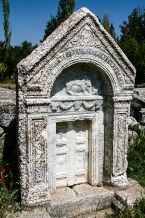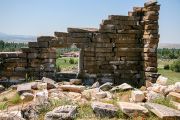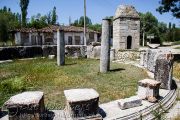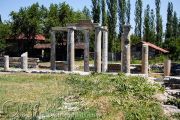The small farming village Çavdarhisar, at about 57 km southwest of Kütahya, is the site of the ancient city of Aizanoi, famed for its temple of Zeus, one of Turkey's best-preserved Roman temples. The ruins of temple and theatre are so impressive that the site is often called Turkey's second Ephesus. The Romans Latinized the name of the city as Aezani. Since 2012, Aizanoi is on the UNESCO World Heritage tentative list
History of Aizanoi
Little is known about the early history of Aizanoi, before the arrival of the Romans. Settlement of the area probably started in the Bronze Age, the 3rd Millenium BCE. The name of the city refers to the mythical hero and legendary ancestor of the Phrygians, Azan, one of the three sons of the legendary king Arkas and the nymph Erato, the Muse of lyric poetry.
Aizanoi was the capital of the region Aizanitis which belonged to Phrygia. During the Hellenistic period, the region alternated between the rule of Pergamon and Bithynia. In 133 BCE the Romans took over and made it part of their province Phrygia Pacatiana. The significance of the city grew, as its location was very strategic on the important trade route through Asia Minor. Moreover, Aizanoi was a significant producer of cereals, wine, and sheep. In the early Imperial Period until the 3rd century CE, monumental buildings, such as the temple of Zeus, were erected and the city's infrastructure was developed.
In the early Byzantine period, Aizanoi was the seat of a Christian bishopric, but by the 7th Century CE, its importance diminished and it fell into decline. In Seljuk times, Çavdar Tatars arrived and converted the temple hill into a citadel, after which the settlement Çavdarhisar (Fortress of the Çavdar) is named. In 1824 European travellers discovered the ruins.
Sights and Photos
The highlight of a visit to Aizanoi is the great temple of Zeus which dominates the site from its position on top of a large rectangular terrace. It was built by command of Emperor Hadrian in 125 CE and dedicated to both Zeus and the Anatolian mother goddess Cybele, whose bust statue now stands in front of the temple. The temple is 35 m × 53 m and has fifteen columns on the side and eight at the end. The Zeus-temple of Aizanoi is unique in its architecture and is one of the few remaining antique buildings in the world whose original form is preserved. Under the basement is a vaulted room, which was a sanctuary devoted to the cult Meter Steunene, the Phrygian goddess of rocks and mountains, an aspect of the goddess Cybele.
The necropolis contains some nice examples of Phrygian door-shaped tombstones and sarcophagi. The doors on the gravestones symbolize the passage to the other world.
Another unique construction in Aizanoi is the combined stadium-theatre. The stadium with a capacity of 13,500 people was constructed adjacent to the theatre with a capacity of 20,000 people, which was unique in the ancient world. The entrance of the stadium shows honorific inscriptions to celebrate the winners of the games.
The macellum (Round Building) was constructed in the 2nd century CE and served as a food market. Inscriptions on the walls of this building show the prices of all goods sold in the market as an effort by Emperor Diocletianus to fight inflation. From the inscriptions, we learn that a strong slave had the same price as two donkeys and a horse was worth three slaves.
Finally, there is a collonaded street dating from the 4th century CE. Unfortunately, the temple of Artemis was demolished for its construction.
Here are the photos of Aizanoi, click on the thumbnail to see a greater picture.
https://turkeyphotoguide.com/aizanoi?tmpl=component&print=1&layout=default#sigProId16dd493bb0
Travel Information & Travel Tips
There are no hotels in Çavdarhisar. We came by taxi from Kütahya, which took a bit less than an hour. There are also minibuses Kütahya's bus station.
